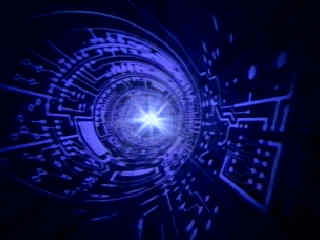"Cyberspace. A consensual hallucination experienced daily by billions of legitimate operators, in every nation, by children being taught mathematical
concepts...A graphical representation of data abstracted from the banks of every computer in the human system."
(Neuromancer)
Creating a personal Icon
 A netrunner's personal icon is the image she portrays of herself while in the net. This icon can be anything,
from an animal or person to a geometric form. The Icon takes no space on your computer or cyberdeck, as it is a
creation of the interface between your person and the Ihara-Gubb Transformation Algorithms that shape the net as we know it.
Because the Icon is not represented by a coded image fragment, the Icon is shaped by your conscious will and your
interface. This means that the better you interface and the stronger you present yourself, the sharper your icon will
be. Compare the total of your character's COOL and INT stats and their INTERFACE skill on the table below to determine Icon
resolution.
Persons surfing on a 'trode connection automatically lose one full resolution step because of interface degradation,
while those using low-impedance cables get +1 on the table (but not one resolution step). Persons surfing in through a
keyboard connection are represented by a standardized low-rez graphic of a human male that can have customized coloration for skin,
hair, pants and shirt.
Beacuse this system is based on your personal interface with the Ihara-Gubb Transformation Algorithms, a character's
personal Icon is very difficult to change, allowing it to act as a "fingerprint". If a character wants to he or she can
attempt to transcribe themselves a new Icon, but not only does this take time (treat as a first-time net-head - see below - but
increase the resolution 2 stages per netrun), but it should be done with a new cyberdeck or at least with a new OS in the deck
so the internal Ihara-Gubb Transformation Map Software doesn't recognize you. (otherwise you may slip back into your old Icon
in moments of stress).
Optional Characters without interface (first-time net-heads) get a -10 modifier to their
icon definition. This modifier is reduced by 1 every two times they jack in to the net and work on their Icon. This represents
the amount of work it takes to express your will upon the Ihara-Gubb Transformation Algorithms. Also a character can increase her Icon
resolution through practice to levels up to 5 points higher than her maximum in this same manner, but it requires 20 hours of
hard work testing the limits of your net ability and performance per +1 resolution.
| Total | Resolution |
| 0-7 | Blurred: the Icon is, for all intents and purposes, a colorized static "ball" with no discernable edges. |
| 8-12 | Fuzzy: the Icon has some semblance to the form intended, but no solid edges are visible. Instead much of the detail is lost to colored static "fuzz". |
| 13-16 | Lo-Rez: the Icon appears as either a sharp-edged low-resolution image or as a blurry, soft-edged high-resolution image. |
| 17-20 | Hi-Rez: the Icon now has lost almost all blurred edges and looks like a quality computer-image. |
| 21-24 | Photo-Realistic: the Icon starts to lose any obvious computer source, looking more like a photograph, with little discernable pixelation. |
| 25-28 | Super-Realistic: the Icon is now as real as real life. There is no edge-blur and no pixelation. This is what professionals strive for. |
| 29+ | Ultra-Sharp: the Icon is now so sharp as to start to lose realism. Light reflects perfectly from reflective surfaces, edges look like they can cut, textures are more perfect than real. |
Purchasing or Coding an Avatar Icon
If you just can't cut it in the net, and refuse to surf around as a ball of green static, then Avatar Icons are always
available. These are VR-coded Icons that you set to interact with the Ihara-Gubb Algorithms to produce the look you want. In
this way any joe user can have a super-realistic icon and surf with the best of them. The down side is that an Avatar takes
up 1 MU, and it's presence requires the acknowledgement of the local IG Processor (meaning you leave a net trail wherever you
go if NetWatch or someone at InterNet decides to track you down). In addition, detection softs will see through the Avatar to
your personal Icon, and many BBSs and Private VRs will not allow Avatar access.
New net.roles:
net.lawyer
Interface
Awareness
Specific Know:Law
Library Search
Education
Persuasion
Human Perception
System Knowledge
Interrogate or Interview
Personal Specialty
|
net.cop
Interface
Authority
System Knowledge
Awareness
Education
Specific Know: Software
Interrogate
Intimidate
CyberDeck Design
Streetwise
|
net.private.investigator
Interface
Research
Awareness
Human Perception
Persuasion
System Knowledge
Social
Streetwise
Interview
Personal Specialty
|
|
net.media
Credibility
Awareness
Composition
Education
System Knowledge
Human Perception
Interview
Programming
Social
Streetwise
|
net.fixer
StreetDeal
Awareness
System Knowledge
Specific Know: Software
Library Search
Social
Persuasion
Forgery
Education
CyberDeck Design
|
|
